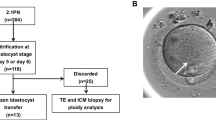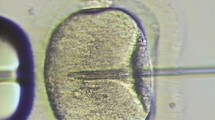Abstract
Transgenes included in genomic-type constructs, such as yeast artificial chromosomes (YAC), P1-derived artificial chromosomes, or bacterial artificial chromosomes (BAC), are normally correctly expressed, according to the endogenous expression pattern of the homologous locus, because their large size usually ensures the inclusion of all regulatory elements required for proper gene expression. The use of these large genomic-type transgenes is therefore the method of choice to overcome most position effects, commonly associated with standard-type transgenes, and to guarantee the faithful transgene expression. However, in spite of the different methods available, including pronuclear microinjection and the use of embryonic stem cells as vehicles for genomic transgenes, the generation of transgenic animals with BACs and, particularly, with YACs can be demanding, because of the low efficiencies requiring extensive microinjection sessions and/or higher number of oocytes. Recently, we have explored the use of intracytoplasmic sperm injection (ICSI) into metaphase II oocytes as an alternative method for the generation of YAC transgenic mice. Our results suggest that the use of transgenic strategies based on ICSI significantly enhances the efficiency of YAC transgenesis by at least one order of magnitude.


Similar content being viewed by others
References
Auerbach AB, Norinsky R, Ho W, Losos K, Guo Q, Chatterjee S, Joyner AL (2003) Strain-dependent differences in the efficiency of transgenic mouse production. Transgenic Res 12:59–69
Celebi C, Guillaudeux T, Auvray P, Vallet-Erdtmann V, Jegou B (2003) The making of “transgenic spermatozoa”. Biol Reprod 68:1477–1483
Garcia-Vazquez FA, Gutierrez-Adan A, Gadea J (2006) Sperm treatment affects the efficiency of porcine transgenic embryo production by ICSI. Reprod Fertil Dev 18:294
Giraldo P, Montoliu L (2001) Size matters: use of YACs, BACs and PACs in transgenic animals. Transgenic Res 10:83–103
Giraldo P, Montoliu L (2002) Artificial chromosome transgenesis in pigmentary research. Pigment Cell Res 15:258–264
Gutierrez-Adan A, Pintado B (2000) Effect of flanking matrix attachment regions on the expression of microinjected transgenes during preimplantation development of mouse embryos. Transgenic Res 9:81–89
Hirabayashi M, Kato M, Aoto T, Sekimoto A, Ueda M, Miyoshi I, Kasai N, Hochi S (2002) Offspring derived from intracytoplasmic injection of transgenic rat sperm. Transgenic Res 11:221–228
Horiuch T, Emuta C, Yamauchi Y, Oikawa T, Numabe T, Yanagimachi R (2002) Birth of normal calves after intracytoplasmic sperm injection of bovine oocytes: a methodological approach. Theriogenology 57:1013–1024
Jakobovits A, Moore AL, Green LL, Vergara GJ, Maynard-Currie CE, Austin HA, Klapholz S (1993) Germ-line transmission and expression of a human-derived yeast artificial chromosome. Nature 362:255–258
Kaneko T, Moisyadi S, Suganuma R, Hohn B, Yanagimachi R, Pelczar P (2005) Recombinase-mediated mouse transgenesis by intracytoplasmic sperm injection. Theriogenology 64:1704–1715
Kurome M, Ueda H, Tomii R, Naruse K, Nagashima H (2006) Production of transgenic-clone pigs by the combination of ICSI-mediated gene transfer with somatic cell nuclear transfer. Transgenic Res 15:229–240
Mackenzie A (2006) Production of yeast artificial chromosome transgenic mice by pronuclear injection of one-cell embryos. Methods Mol Biol 349:139–150
Migeon BR, Kazi E, Haisley-Royster C, Hu J, Reeves R, Call L, Lawler A, Moore CS, Morrison H, Jeppesen P (1999) Human × inactivation center induces random X chromosome inactivation in male transgenic mice. Genomics 59:113–121
Montoliu L (2003) In: Nagy A, Gertsenstein M, Vintersten K, Behringer R (eds) Manipulating the mouse embryo. A laboratory manual, 3rd edn. Cold Spring Harbor Laboratory Press, Cold Spring Harbor, New York, pp 326–333
Moreira PN, Jimenez A, Fernandez R, Bury-Madrid N, De la Fuente J, Pintado B, Gutierrez-Adan A (2003) Mouse ICSI with frozen-thawed sperm: the impact of sperm freezing procedure and sperm donor strain. Mol Reprod Dev 66:98–103
Moreira PN, Giraldo P, Cozar P, Pozueta J, Jimenez A, Montoliu L, Gutierrez-Adan A (2004) Efficient generation of transgenic mice with intact yeast artificial chromosomes by intracytoplasmic sperm injection. Biol Reprod 71:1943–1947
Moreira PN, Pozueta J, Giraldo P, Gutierrez-Adan A, Montoliu L (2006a) Generation of yeast artificial chromosome transgenic mice by intracytoplasmic sperm injection. Methods Mol Biol 349:151–162
Moreira PN, Perez-Crespo M, Ramirez MA, Pozueta J, Montoliu L, Gutierrez-Adan A (2006b) Effect of transgene concentration, flanking matrix attachment regions, and RecA-coating on the efficiency of mouse transgenesis mediated by intracytoplasmic sperm injection. Biol Reprod 2006 Oct 11 [Epub ahead of print]
Osada T, Toyoda A, Moisyadi S, Akutsu H, Hattori M, Sakaki Y, Yanagimachi R (2005) Production of inbred and hybrid transgenic mice carrying large (>200 kb) foreign DNA fragments by intracytoplasmic sperm injection. Mol Reprod Dev 72:329–335
Perry AC, Wakayama T, Kishikawa H, Kasai T, Okabe M, Toyoda Y, Yanagimachi R (1999) Mammalian transgenesis by intracytoplasmic sperm injection. Science 284:1180–1183
Perry AC, Rothman A, de las Heras JI, Feinstein P, Mombaerts P, Cooke HJ, Wakayama T (2001) Efficient metaphase II transgenesis with different transgene archetypes. Nat Biotechnol 19:1071–1073
Pozueta J, Moreira PN, Gutierrez-Adan A, Valdivieso F, Montoliu L (2005) Generation of a transgenic YAC mouse as a tool for the study of sporadic Alzheimer disease. In: Program and abstracts of the 6th transgenic technology meeting (TT2005). Transgenic Res 14:511
Schedl A, Montoliu L, Kelsey G, Schutz G (1993a) A yeast artificial chromosome covering the tyrosinase gene confers copy number-dependent expression in transgenic mice. Nature 362:258–261
Schedl A, Larin Z, Montoliu L, Thies E, Kelsey G, Lehrach H, Schutz G (1993b) A method for the generation of YAC transgenic mice by pronuclear microinjection. Nucleic Acids Res 21:4783–4787
Smith K, Spadafora C (2005) Sperm-mediated gene transfer: applications and implications. Bioessays 27:551–562
Strauss WM, Dausman J, Beard C, Johnson C, Lawrence JB, Jaenisch R (1993) Germ line transmission of a yeast artificial chromosome spanning the murine alpha 1(I) collagen locus. Science 259:1904–1907
Suganuma R, Pelczar P, Spetz JF, Hohn B, Yanagimachi R, Moisyadi S (2005) Tn5 transposase-mediated mouse transgenesis. Biol Reprod 73:1157–1163
Villuendas G, Gutierrez-Adan A, Jimenez A, Rojo C, Roldan ER, Pintado B (2001) CMV-driven expression of green fluorescent protein (GFP) in male germ cells of transgenic mice and its effect on fertility. Int J Androl 24:300–305
Whitelaw CB (2004) Transgenic livestock made easy. Trends Biotechnol 22:157–159
Whitelaw CB, Springbett AJ, Webster J, Clark J (1993) The majority of G0 transgenic mice are derived from mosaic embryos. Transgenic Res 2:29–32
Acknowledgements
This work was supported by grants AGL2006-04799 to AGA and BFU2006-12185/BMC to LM, from the Spanish Ministry of Education and Science (MEC). The authors are grateful to Belen Pintado and Glen Jeffery for critical review of this manuscript.
Author information
Authors and Affiliations
Corresponding author
Rights and permissions
About this article
Cite this article
Moreira, P.N., Pozueta, J., Pérez-Crespo, M. et al. Improving the generation of genomic-type transgenic mice by ICSI. Transgenic Res 16, 163–168 (2007). https://doi.org/10.1007/s11248-007-9075-1
Received:
Accepted:
Published:
Issue Date:
DOI: https://doi.org/10.1007/s11248-007-9075-1




